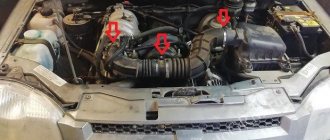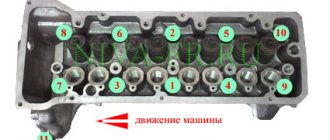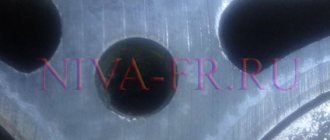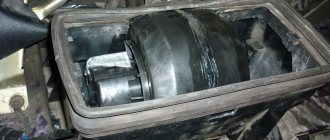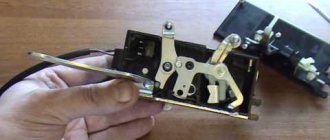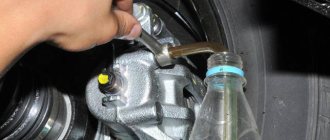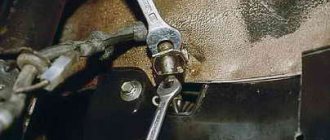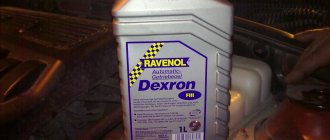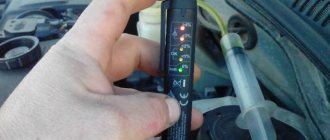There is a need to revise the power steering line. The main reason was sweating hoses and the tank itself, or rather its lid, or more precisely the o-ring. And due to age, it’s time to change the fluid.
Tank. You can take any one that is cheaper. LADA
2123-3410010 LADA / General Motors 2123-03410010-00-0 Repair Comm
RK07001 Power steering fluid - Pentosin CHF11S
Pentosin CHF11S Pentosin 1405116 BMW / Fuchs 83290429576 VAG G00 200 0A2 *These numbers are all the same same liquid CHF11S. **For a complete replacement with flushing, one liter is not enough to get it clean!
Oil and petrol resistant hoses GATES 3225-10015
—
hose 12mm (2m) GAS
ШМБС16X1000 —
hose 16mm (1m)
Spring clamps. NORMA FBS2412
—
2 pcs. NORMA
FBS1912 —
4 pcs.
Below watch the video about replacing low pressure hoses on a Chevrolet Niva and express your opinion about it in the reviews of the article.
Video quality: DTVRip
The video was uploaded to the admin from the user Avksentiy: for immediate viewing on the portal.
To give the correct answer to the question Replacing low-pressure power steering hoses on a Chevrolet Niva, you need to watch the video. After viewing, you will not need to seek help from specialists. Detailed instructions will help you solve your problems. Enjoy watching.
Humor in the topic: The worker came to the sanatorium on a voucher. In the morning, from a wild hangover, he surveys the beach... Shielding himself from the bright sun with his palm, he examines the half-naked audience: - Rest, heal... Here you can work and work!
Tools:
- Key for 10
- Container for draining liquid
- Phillips screwdriver
Parts and consumables:
- Fluid - power steering oil
- Rags
Notes: Replace the fluid in the power steering system if it is excessively dirty. The manufacturer does not give clear recommendations on the frequency of replacing fluid in the hydraulic system, so we recommend replacing it after six years, regardless of its condition.
For use in the hydraulic system of the amplifier, the manufacturer recommends a fluid - Pentosin Hidraulik Fluid CHF11S oil. However, for technological reasons, cars starting with VIN No. X9L21230040005880 use Shell Donax TA D-21631 (Dexron II) hydraulic fluid in the hydraulic system, and with VIN No. X9L21230040006248 - Ravenol Dexron II D. Cars filled with Shell Donax oil have a mark on the tank - “*”, and cars filled with Ravenol Dexron II D are marked “R”, but on cars of the latest production these marks may not be present.
Dexron II fluids (red) cannot be mixed with Pentosin Hidraulik Fluid CHF11S (green). It is possible to completely replace the fluid after flushing the power steering hydraulic system.
When using Dexron II fluids, reduce the period of use by half the recommended time.
1. Remove the pinch bolt of the power steering reservoir reservoir bracket.
2. Unscrew the tank cap.
3. Remove the reservoir from the bracket and drain the liquid from the reservoir into a suitable container.
Niva Chevrolet Niva Chevrolet replacing the heater hose using the dentist's method
Intensive use of the Chevrolet Niva makes the color of the power steering oil darker over time, often with a burning smell. This is a reason to think about replacing it.
Overheating of the oil often occurs when the steering wheel is held in the extreme position for a long time, until it boils; the pressure in this case is maximum.
You should also not leave your car parked for a long time with the steering wheel turned all the way. There are two ways to replace the fluid in the Chevrolet Niva power steering: To partially replace the power steering oil, you will need a syringe with a tube and the oil itself, enough so that at the end of the work it will no longer be dark.
Transmission Chevrolet Niva (Chevrolet Niva). Structure and operation of mechanisms. (copy of video)
Using a syringe with a tube, completely pump out the fluid from the power steering reservoir. Fill the reservoir with new fluid to the MAX level.
Chevrolet Niva 2005, 80 l. With. — scheduled maintenance
We start the engine and turn the steering wheel left and right to the extreme position. Drive onto an overpass, or jack up the car so as to hang the front wheels of the Chevrolet Niva, in order to be able to easily rotate them with the engine not running.
Use a syringe with a tube to remove as much old oil as possible from the tank. Now you need to determine through which hose the oil enters the Chevrolet Niva power steering expansion tank - this is the return, and through which it leaves and goes to the power steering pump. Disconnect the hose through which the oil enters the return tank.
The topic is power steering hoses for Chevrolet and Niva. Gur - power steering. In this article I want to talk about how to correctly and with what to fill the hydraulic part of the steering system in order to increase its service life and reduce the effort on the steering wheel. And also how German operating recommendations differ from the Russian view on this topic.
Suspected damage
During operation, motorists may encounter different types of hydraulic damage, after which repair of the power steering hoses is necessary. The following points can be noted:
- Manufacturer defect . This feature is typical for insufficiently known hydraulic equipment manufacturing companies. Failure is characterized by poor-quality crimping of the joint of a sleeve or fitting. This happens when the equipment is undebugged or incorrectly configured.
- Operational output . Damage occurs due to wear and tear during operation of the mechanism. The main problems are cord breaks, cuts and frayed areas. This often occurs due to hose sagging due to incorrectly selected length.
- Structural inconsistencies . Failure occurs due to the installation of equipment that does not meet the specifications specified by the automaker. In such situations, a wire rupture or fittings may break due to a discrepancy between the pressure in the system and the permissible value for the hose.
- Disagreement in temperature or chemical characteristics . Damage to the structure can occur during operation at an ambient temperature for which such rubber was not designed, as well as during the use of aggressive chemicals in the structure of the working fluid.
Damage to power steering hoses
The manufacturer indicates all characteristics and permissible operating parameters for each hose in the instructions for use.
Hydraulic malfunctions with which further operation of the vehicle is not recommended:
- fittings are significantly damaged by corrosion processes;
- significant fracture of the sleeve;
- significant abrasion of the outer part of the hose;
- the presence of complete or partial blockage inside the sleeves;
- lack of sealing of connections;
- failure of the fitting from the landing diameter;
- liquid leakage at joints;
- deformation or damage to the inner surface from high pressure or excess temperature.
In all cases, replacement or repair of the hose is required.
Story
I have already said many times that I do not do tuning or modifications for the sake of the process. Only if there are problems. In this case, it all started with the “collective farmers” of AvtoVAZ. For a very long time, the plant installed German ZF power steering pumps on the assembly line, and then suddenly the Russian version came into use. As usual, the plant was not going to give any explanations, so I had to turn to another source, the manufacturer ZF. A technical seminar organized by this company was held in St. Petersburg, and I asked the German a question about this situation. Directly at the lecture (that is, the official position), the German specialist said that this is a trade secret. And during the lunch break, when I addressed him in German, he straightened up and said the following. Quote. Along with the supply of pumps, we gave a recommendation to AvtoVAZ on what SHOULD be poured into the system. At first, the plant filled it with an approximate analogue of the liquid that we recommended, and then suddenly it started pouring green Pentosin. The result was not long in coming - leaks and a humming sound when turning. But the funny thing is that all these “supposedly” warranty cases were transferred to the shoulders of ZF. The German said that we “butted heads” with the plant a little, did not get clear answers from the managers and management and simply stopped supplying this spare part. End of quote. Now we come to a simple conclusion: in order to get a working unit, as intended by the designers, we need to flush the system and fill it with what is recommended. The fluid is simple, good synthetic dextron, but along with it I recommend replacing the low pressure hoses.
Carrying out repairs
Based on the nature of possible damage, it can be assumed that the most common repair of power steering hoses involves putting the fittings in order or replacing individual parts of the hose. To carry out the replacement, crimping with couplings will be necessary.
Tools for DIY repairs
The work algorithm may be as follows:
- The damaged hose must be disconnected from the system.
- The new hose will need to be the same length so as not to create unnecessary sagging. The measurement is carried out from nipple to nipple. At the same time, we select a hose that satisfies all geometric data and pressure parameters. The markings indicated on the outside by the manufacturer will help with this. The internal diameter will also be indicated there.
- When repairing a high-pressure hose, the ends are stripped both outside and inside to the metal braid. The procedure is carried out faster using debarking machines.
- Fittings are selected according to geometric parameters and technological thread data. Measurements are easy to take using a caliper and thread gauge. Domestic and foreign fittings may differ from each other according to several criteria, so it is better to take measurements yourself.
- We crimp the fittings using crimping equipment, using suitable removable jaws in each case.
- Using a control probe, we determine the quality of the work performed. At specialized factories, this operation is carried out using special industrial stands.
For non-standard connections, repair kits with recommended fittings must be used. You can disconnect the head of the old fitting, if it is not damaged, and solder it to the part to be crimped. This option is used in extreme cases, since the effect of this repair is short-lived.
Hoses for power steering Niva Chevrolet, life
The power steering system consists of 4 hoses. One high pressure with a valve in the middle (pump-steering machine) and 3 low pressure hoses. In the designer's fields, the radiator was completely excluded from the system, so there are only two low-pressure hoses. The pressure in the “main” hose reaches several tens of kg, but there is almost no pressure in the “secondary” hoses. The plant, with the tenacity of maniacs, installs rough, thick-walled high-pressure hoses. Their disadvantage is that they cannot normally be compressed even with threaded clamps, especially in cold conditions. So their wet appearance is normal. The recommendation is simple, along with replacing the fluid and flushing the system - replace the Chevrolet Niva power steering hoses with modern and high-quality ones. Since I don’t really like stepping on rakes, I consulted with a hydraulic engineer on this topic. He “gave me” a Taiwanese hose manufacturer. The working pressure of the hoses is 250PSI (approximately 17 atmospheres). For general technical development, let me remind you that PSI is pounds per square inch. The hoses are two-layer. The internal part is MBS (oil and petrol resistant), the external part maintains external temperatures. Based on many years of installation experience on different machines, I can say the following. No cracks have ever been noticed in any climate. The most I have noticed is fading after a couple of years of use in hot climates, but as you know, this does not affect the speed. I added a couple of centimeters to the length of the hoses so that they would not rub against the air filter housing, as often happens in the factory version. For the Niva, the price list will include an option of two hoses.
Hydraulic operation
Hoses, which are often called high-pressure hoses, are flexible pipelines whose main task is pumping working fluids. The transported material is specially prepared motor oils or working fluids based on mineral oils, aqueous solutions of emulsols, glycol, and greases.
Without high-quality flexible hoses that can withstand the required pressure and an extensive pipeline system, it is difficult to imagine the operation of a hydraulic booster. In addition to the direct duty related to pumping working fluid, such hoses act as dampers (compensators), increasing the operational period of connecting elements, fittings, fittings and the system as a whole.
Vibration absorption by flexible elements contributes to obtaining such results. The negative side of the phenomenon is that periodic replacement or repair of power steering hoses in worn areas is required. After all, all abrasions or kinks soon lead to the tube leaking .
Structural elements of power steering
by wpadm August 11, 2016
From the above it is clear that the hydraulic booster is an important part of a modern car. The entire power steering complex consists of the main elements:
- Oil injection pump;
- Spool type distributor;
- Power cylinder;
- Reservoir with lid and oil filter;
- Power steering radiator;
- Connecting hoses;
- Tube systems with adapters.
The pump itself, which is rotated by the engine motor through the power steering belt, provides the entire system with oil, which constantly circulates through the pipes with the required pressure.
Driving oil through the system circuit is the main ability of the power steering pump. The main installation location is on the side of the engine, where there is a special power steering bracket.
The power steering drive may be the main reason for poor power steering performance. If the drive belt breaks, the entire system stops working. detect the moment when the power steering drive belt : kickback (reverse push) of the steering wheel.
It is especially noticeable when the car is moving from a standstill with the steering wheel turned. The power steering roller helps maintain constant tension on the drive belt . If the drive belt breaks, the power steering allows you to maintain control over the control of the machine using the spool.
Distributor - location, both on the shaft and with mounting on other elements of the steering mechanism. Its main task is to distribute the flow of working fluid between the power steering and the return flow to the power steering reservoir.
It is classified into two types - rotary and axial, according to the types of spool movement. Axial – makes translational movements. The rotary one rotates. This element is very sensitive to contamination of the working fluid in the system - dirty and poor-quality fluid will create problems in the operation of the distributor.
The power steering reservoir is a plastic container that contains the working fluid. Inside it there is a power steering filter, which pre-cleanses the poured oil from foreign particles.
The power steering cover is equipped with a built-in dipstick with marked marks, which can be used to determine the fluid level in the reservoir. If the level drops significantly, you should pay attention to the tightness of the connections of tubes, hoses, etc.
Power steering connecting there are several of them in the power steering system. They provide the connection of individual elements into one common system through which the working fluid is supplied.
They are divided into two types of hoses - high and low pressure. High pressure hoses provide oil flow to the pump, distributor and main cylinder. The waste fluid flows back into the tank through low pressure hoses.
double-acting power steering cylinder The power steering rack is integrated with the power cylinder and responds to the rotation of the steering column. helps improve durability and smooth operation .
Power steering gearbox - its joint work with the distributor ensures the flow of oil into the desired cavity of the cylinder or return excess back to the reservoir. The working fluid in the power steering system is special grade oil.
In addition to the operation of the entire system, it provides additional lubrication of all rubbing parts of the system.
Power steering radiator - cools the system oil during power steering operation. In addition to the listed components, various distributor designs may also contain additional parts:
To repair the power steering cylinder, you may need a power steering repair kit. It is unique for each car model and is selected individually. Periodic replacement (once every two years) of the working fluid will help increase the service life of individual power steering elements.
New structural elements
Car manufacturers, in order to reduce the pressure in the power steering system when the vehicle moves in a straight line, install an electronic control unit for the entire system.
At high speeds, such a system regulates oil pressure in such a way that driving the car becomes more informative and the driver always has time to react in time to the slightest change in the trajectory.
But the improvements do not end with the introduction of electrical oil pressure control. The mechanical power steering was replaced by an electric oil pump. The mechanical drive replaced the electric motor, which is capable of changing the rotation speed when the vehicle speed changes.
And the concept cars are already equipped with electric power steering instead of hydraulics.
